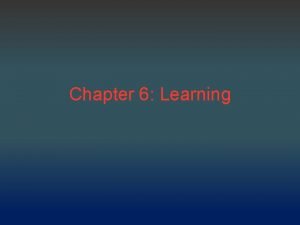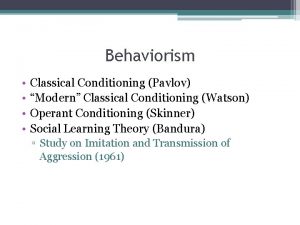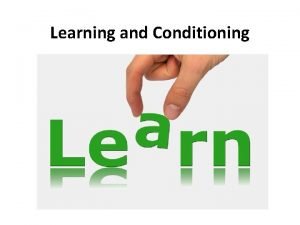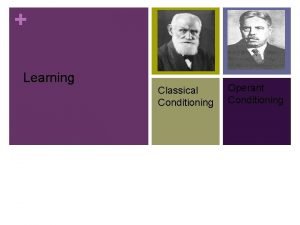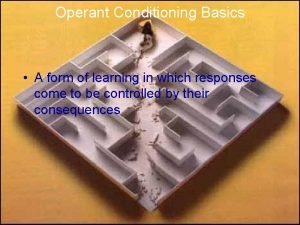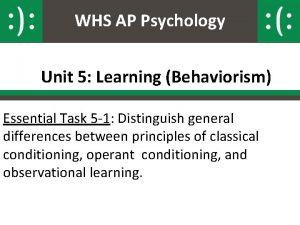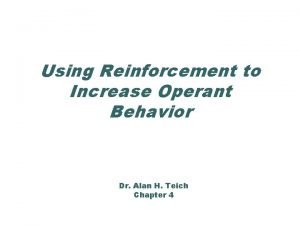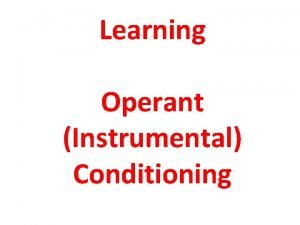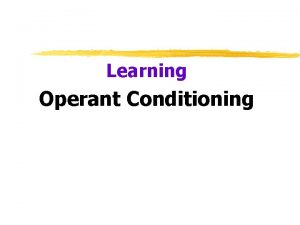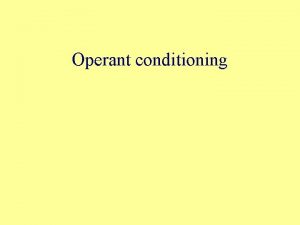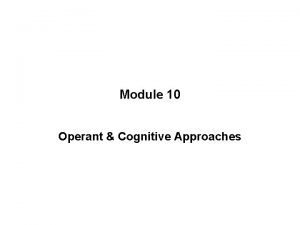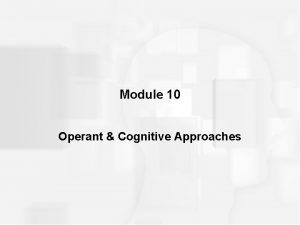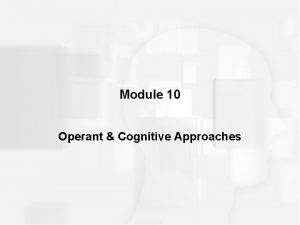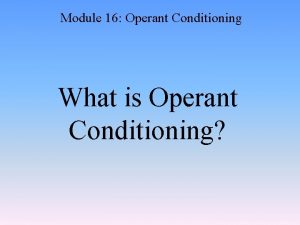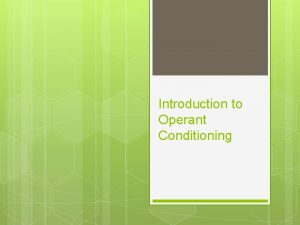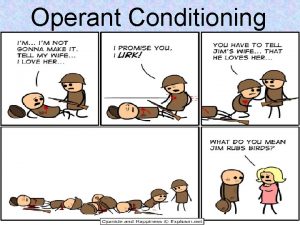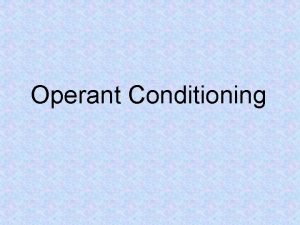Module 20 Operant Conditioning Josef F SteuferGetty Images



















- Slides: 19

Module 20 Operant Conditioning Josef F. Steufer/Getty Images

Operant Conditioning 20 -1: WHAT IS OPERANT CONDITIONING? – Operant conditioning is a type of learning in which behavior is strengthened if followed by a reinforcer or diminished if followed by a punisher. – Actions followed by reinforcers increase; those followed by punishment decrease. – Operant behavior is behavior that operates on the environment to produce rewarding or punishing stimuli. (In contrast, classical conditioning involves respondent behavior—automatic responses to a stimulus. )

Operant Conditioning Behavior operates on the environment to produce rewarding or punishing stimuli. Organisms associate their own actions with consequences. Actions followed by reinforcement increase; those followed by punishments often decrease.

Operant Conditioning Skinner’s Experiments 20 -2: WHO WAS SKINNER, AND HOW IS OPERANT BEHAVIOR REINFORCED AND SHAPED? – B. F. Skinner (1904– 1990), was modern behaviorism’s most influential and controversial figure. – Expanded on Edward L. Thorndike’s law of effect, which states that rewarded behavior tends to recur. – Developed behavioral technology that revealed principles of behavior control. – Designed and used an operant chamber (popularly known as a Skinner box) for experiments that included a bar (a lever) that an animal presses (or a key or disc the animal pecks) to release a reward of food or water, and also a device that records these responses.

Operant Conditioning Skinner’s Experiments Cat in a puzzle box, illustrating Thorndike’s Law of Effect.

Operant Conditioning Skinner’s Experiments – By shaping animals’ natural behaviors, Skinner was able to teach these animals unnatural behaviors (such as teaching pigeons to walk in a figure 8, play Ping. Pong, and keep a missile on course by pecking at a screen target). – Reinforcement: Any event that strengthens the behavior it follows. A Skinner box Inside the box, the rat presses a bar for a food reward. Outside, a measuring device (not shown) records the animal’s accumulated responses.

Operant Conditioning Shaping Behavior – Everyday behaviors are continually reinforced and shaped. – Shaping: Gradually guiding behavior toward closer and closer approximations of the desired behavior. – With this method of successive approximations, responses that are ever-closer to the final desired behavior are rewarded, and all other responses are ignored.

Operant Conditioning: Types of Reinforcers 20 -3: HOW DO POSITIVE AND NEGATIVE REINFORCEMENT DIFFER, AND WHAT ARE THE BASIC TYPES OF REINFORCERS? Positive reinforcement Increases behaviors by presenting positive reinforcers. A positive reinforcer Is any stimulus that, when presented after a response, strengthens the response. Negative reinforcement Increases behaviors by stopping or reducing negative stimuli. A negative reinforce is any stimulus that, when removed after a response, strengthens the response. (Note: Negative reinforcement is not punishment. )

Operant Conditioning: Types of Reinforcers Ways to Increase Behavior

Operant Conditioning: Types of Reinforcers Primary and Conditioned Reinforcers • Primary reinforcer: Is unlearned; innately reinforcing stimuli, such as those that satisfy biological needs • Conditioned (secondary): A stimulus that gains power through association with primary reinforcer Immediate and Delayed Reinforcers • Immediate: Occurs immediately after a behavior • Delayed: Involves time delay between desired response of and delivery of reward

Operant Conditioning Reinforcement Schedules 20 -4: HOW DO DIFFERENT REINFORCEMENT SCHEDULES AFFECT BEHAVIOR? • Reinforcement schedule – A pattern that defines how often a desired response will be reinforced • Continuous reinforcement schedule – Reinforcing the desired response every time it occurs • Partial (intermittent) reinforcement schedule – Reinforcing a response only part of the time; results in slower acquisition of a response but much greater resistance to extinction than does continuous reinforcement

INTERMITTENT REINFORCEMENT SCHEDULES Skinner’s (1961) laboratory pigeons produced four reinforcement schedules. (Reinforcers are indicated by diagonal marks. )

Operant Conditioning Reinforcement Schedules of Partial Reinforcement

Operant Conditioning Punishment 20 -5: HOW DOES PUNISHMENT DIFFER FROM NEGATIVE REINFORCEMENT, AND HOW DOES PUNISHMENT AFFECT BEHAVIOR? • Punishment administers an undesirable consequence or withdraws something desirable in an attempt to decrease the frequency of a behavior (a child’s disobedience). • Positive punishment – Presenting a negative consequence after an undesired behavior is exhibited, making the behavior less likely to happen in the future • Negative punishment – Removing a desired stimulus after particular undesired behavior is exhibited, resulting in reducing behavior in future

Operant Conditioning Punishment Ways to Decrease Behavior

Four Major Drawbacks of Physical Punishment Punished behavior is suppressed, not forgotten. This temporary state may (negatively) reinforce parents’ punishing behavior. Punishment teaches discrimination among situations (perhaps only selectively decreasing the undesired behavior). Punishment can teach fear. Physical punishment may increase aggression by modeling violence as a way to cope with problems.

Operant Conditioning Skinner’s Legacy Applications of Operant Conditioning 20 -6: WHY DID SKINNER’S IDEAS PROVOKE CONTROVERSY, AND HOW MIGHT HIS OPERANT CONDITIONING PRINCIPLES BE APPLIED AT SCHOOL, IN SPORTS, AT WORK, AND AT HOME? • At school: Electronic technologies and adaptive learning software used in teaching and learning have helped realize Skinner’s goal of individually paced, customized instruction with immediate feedback. • In sports: Behavioral methods implemented in shaping behavior in athletic performance. • At work: Rewards successfully used to increase productivity and skill development. • At home: Basic rules of shaping used in parenting, and to reinforce our own desired behaviors.

Reinforcing Desired Behavior and Extinguishing Undesired Ones State a realistic goal in measurable terms. Decide how, when, and where you will work toward your goal. Monitor how often you engage in your desired behavior. Reduce the rewards gradually. Reinforce the desired behavior.

Contrasting Classical and Operant Conditioning 20 -7: HOW DOES OPERANT CONDITIONING DIFFER FROM CLASSICAL CONDITIONING? • Both classical and operant conditioning are forms of associative learning. Both involve acquisition, extinction, spontaneous recovery, generalization, and discrimination. Classical conditional involves respondent behaviors and operant conditioning involves operant behaviors.
 Instrumental learning vs classical conditioning
Instrumental learning vs classical conditioning Difference between operant and classical conditioning
Difference between operant and classical conditioning Skinner's schedules of reinforcement
Skinner's schedules of reinforcement Classical and operant conditioning differences
Classical and operant conditioning differences Classical conditioning vs operant conditioning
Classical conditioning vs operant conditioning Albert experiment
Albert experiment Operant conditioning adalah
Operant conditioning adalah Operant conditioning classical conditioning
Operant conditioning classical conditioning Classical and operant conditioning
Classical and operant conditioning Secondary reinforcer psychology definition
Secondary reinforcer psychology definition What are the different schedule of reinforcement
What are the different schedule of reinforcement Module 27 operant conditioning
Module 27 operant conditioning Operant conditioning images
Operant conditioning images Operant conditioning images
Operant conditioning images Instrumental learning vs classical conditioning
Instrumental learning vs classical conditioning Partial reinforcement
Partial reinforcement Operant conditioning
Operant conditioning Behaviorism ap psychology
Behaviorism ap psychology Skinner's operant learning theory
Skinner's operant learning theory Thinning operant conditioning
Thinning operant conditioning

